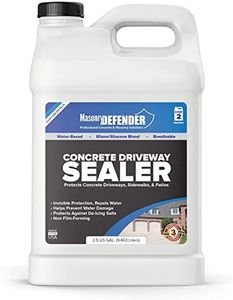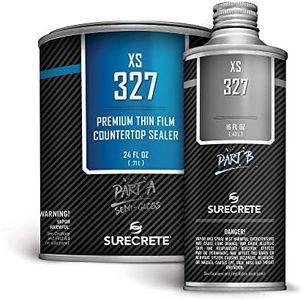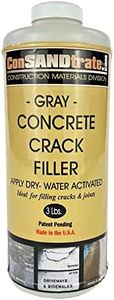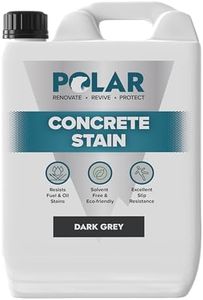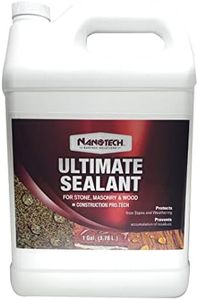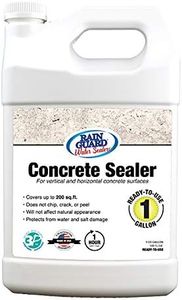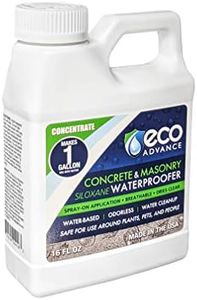We Use CookiesWe use cookies to enhance the security, performance,
functionality and for analytical and promotional activities. By continuing to browse this site you
are agreeing to our privacy policy
10 Best Concrete Stains
From leading brands and best sellers available on the web.By clicking on a link to a third party's website, log data is shared with that third party.
Buying Guide for the Best Concrete Stains
Choosing the right concrete stain can completely transform the look and feel of concrete surfaces, whether you're working on patios, driveways, floors, or countertops. Unlike paints that sit on the surface, stains soak into the concrete and give it a unique look that can mimic stone, marble, or provide a vibrant color. When picking a concrete stain, you’ll want to focus on how you plan to use the space, the durability you require, and the type of finish you prefer. Considering the conditions of the environment (indoors or outdoors) is essential as well, since some stains perform better in certain settings. Understanding key features will help you select the perfect product for your needs.Stain Type (Acid-Based vs. Water-Based)The type of stain refers to its chemical makeup and how it interacts with the concrete. Acid-based stains chemically react with concrete to create unique, variegated color effects and tend to produce earthy, natural tones. They usually become part of the surface, making them long-lasting but less vibrant in color options. Water-based stains, on the other hand, come in a much broader range of colors and act more like a dye, sitting on the surface with less chemical change. They're easier to apply, have lower odor, and clean up with water. If you value subtle, durable, and natural-looking results (especially outdoors), acid-based may be ideal. If you want more color options, faster drying, or you're working indoors, water-based could be better.
Color RangeColor range refers to the variety of shades a stain offers. Acid-based stains tend to be limited to tans, browns, greens, and blue-green hues, giving a stone-like appearance, while water-based stains offer vibrant reds, blues, yellows, and more, including the ability to mix custom colors. When deciding, consider what look you desire—whether it's a natural, mottled effect or a bold, modern statement. Also, keep in mind how the color will work with your existing décor or environment. To pick the right one, visualize your final look and check sample charts; always test in a small area first, as concrete porosity and color can affect the final outcome.
Transparency (Opacity Level)Transparency or opacity describes how much the original concrete shows through after staining. Stains range from translucent (which allows concrete’s texture and imperfections to show for a natural look) to semi-opaque (which gives more solid color coverage but still some depth). If you like a natural, variegated effect and want to see the concrete’s character, choose a more transparent stain. If you're hoping to hide imperfections or create a more uniform color, go for something with higher opacity. Think about the existing condition of your concrete and what effect you want in the finished space when making this choice.
UV ResistanceUV resistance means how well the stain’s color stands up to sunlight exposure without fading. This is particularly important for outdoor surfaces like patios, walkways, or driveways. Stains with good UV resistance will retain their color for years, while those without may fade quickly in direct sun. If your project is outdoors or in a sun-exposed indoor area, make sure the product specifies UV protection. If it's strictly for interior areas shielded from light, UV resistance is less critical.
Drying and Cure TimeDrying and cure time refers to how long it takes for the stain to set and be ready for use or for applying a sealer. Water-based stains typically dry faster (often within a few hours) while acid-based stains may need a day or more, plus neutralizing and rinsing steps. Rapid drying is convenient for projects where downtime is a concern, while longer curing can sometimes mean more durable results. Think about how quickly you need the area back in use, and whether you’re comfortable waiting or prefer a quicker turnaround.
Required Surface PreparationSurface preparation is about how much work needs to be done to get your concrete ready for staining. Clean, bare, and absorbent concrete is key; some stains are more forgiving and work with light prep, while others need thorough cleaning, etching, and repairing. Highly decorative or delicate finishes generally require more careful prep. If you prefer a simpler process or aren’t comfortable with major prep work, choose a stain that’s more tolerant of minor residues or uneven surfaces. Always follow manufacturer recommendations to ensure the best results.
VOC Content and SafetyVOC (volatile organic compounds) content affects air quality and health during application. Lower VOC stains are safer for indoor use and offer a more pleasant experience with fewer fumes. Acid-based stains generally have higher VOCs, but many modern water-based options are low-VOC and better for users with sensitivities or for spaces with limited ventilation. If you’re working indoors, around children or pets, or are sensitive to odors, prioritize low-VOC or no-VOC options.
Maintenance and LongevityMaintenance covers how often you’ll need to clean, reseal, or redo your staining to keep surfaces looking good. Some stains, especially those used in high-traffic or outdoor areas, may require occasional resealing to protect color and finish. Acid-based stains tend to last longer with less maintenance but can be harder to touch up, while water-based stains might need more frequent attention but are easier to reapply. Consider how much ongoing care you’re willing to provide and balance that with the area’s use and exposure.
